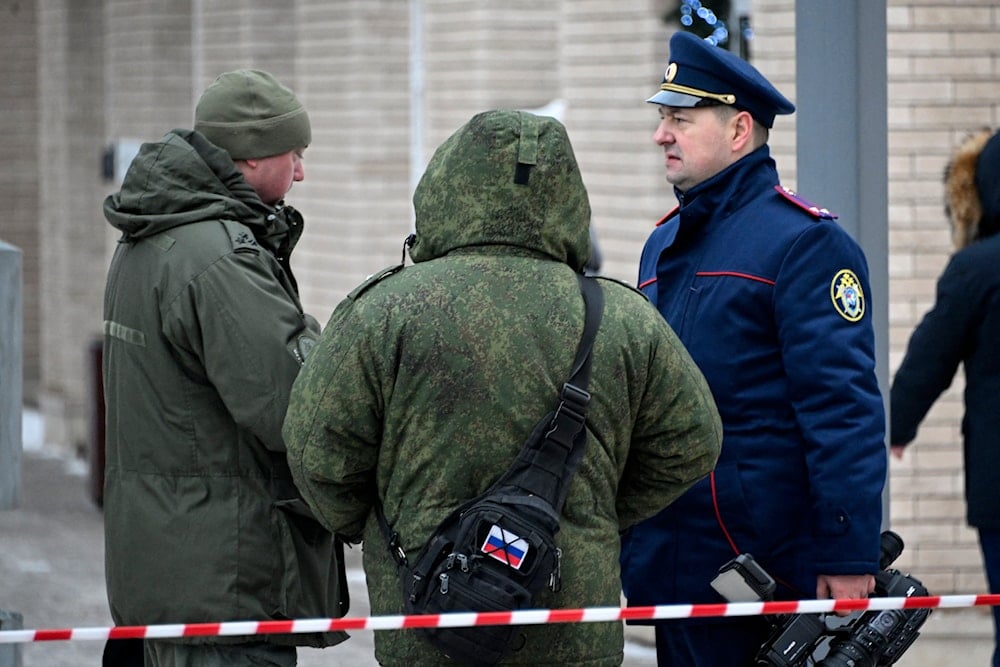FSB arrests perpetrator of bombing that killed General Kirillov
Russia's Federal Security Service says the attacker, reportedly recruited by Ukrainian special services, was apprehended following a joint investigation.
-

Investigators work at the blast scene, which killed the commander of Russian armed forces' chemical, biological and radiation defence troops, Igor Kirillov, and his assistant, according to the Russian Investigative Committee, outside a residential building on Ryazansky Avenue in Moscow on December 17, 2024 (AFP)
Russia's Federal Security Service (FSB) announced on Wednesday the detention of the individual responsible for the attack that killed Lt. Gen. Igor Kirillov, head of the Russian armed forces' Radiological, Chemical, and Biological Defense Troops.
The attacker, reportedly recruited by Ukrainian special services, was apprehended following a joint investigation, the FSB confirmed.
Kirillov and his aide, Maj. I.V. Polikarpov, were killed in a bomb explosion early Tuesday in Moscow, according to the Russian Investigative Committee.
An official from Ukraine's Security Service (SBU) told The New York Times that Ukraine was behind the attack.
In a statement, the FSB said it has "identified and detained a citizen of Uzbekistan, born in 1995, who detonated a homemade explosive device near a residential building on Ryazanskiy Prospekt in Moscow," which resulted in the killing of Kirillov and Polikarpov.
According to the statement, the attacker admitted to being recruited by Ukrainian intelligence, revealing that he had been directed to Moscow, where he was provided with a powerful homemade explosive device, which he later planted on an electric scooter parked near Kirillov's residential building.
To monitor the general's residence, the perpetrator rented a car equipped with a Wi-Fi camera, transmitting real-time footage to his handlers in Ukraine, the FSB noted. It revealed that the attacker was promised a $100,000 reward and relocation to an EU country in exchange for carrying out the assassination.
The FSB said the attacker faces a maximum sentence of life imprisonment, vowing that the Ukrainian special services personnel involved in orchestrating the attack would be identified and held accountable.
Zakharova says has 'no doubts' about who ordered General Kirillov's killing
On her part, Russian Foreign Ministry spokeswoman Maria Zakharova told RIA Novosti that she did not have doubts about who ordered the killing of Lt. Gen. Igor Kirillov, head of the Troops of Radiological, Chemical and Biological Defense of the Russian armed forces.
"Our investigation will certainly establish all details. I have no doubts about who was the contractor and who was the customer," Zakharova said.
Zakharova said previously that Kirillov's murder was the result of the West giving Ukraine carte blanche to commit war crimes.
Ukrainians used white phosphorus in September: Zakharova
In a related context, she also affirmed that Russian law enforcement agencies received evidence of the repeated use of white phosphorus munitions by the Ukrainian armed forces in September.
"Law enforcement agencies of our country, together with the Russian Ministry of Defense, have obtained irrefutable evidence of the repeated use of white phosphorus by the Ukrainian armed forces in September as self-igniting filling for ammunition dropped from drones," Zakharova told reporters.
This fact indicates that Ukraine has chemical weapons that have not been disposed of in accordance with international regulations, as well as the possibility of synthesizing highly toxic phosphorus-containing toxic substances, the diplomat added.
Meanwhile, Michael Maloof, a former senior security policy analyst in the Office of the US Secretary of Defense, told Sputnik, that Kirillov’s role in exposing Ukraine’s role in US-backed chemical and biological research made him a target.
"What he has been doing is revealing the extent to which Ukraine has been involved in illegal US chemical and biological research," he indicated, highlighting the sensitive nature of these revelations.
“I know it was very sensitive because Victoria Nuland, in testimony before Congress last year, I believe it was, said that it would not be good if Russia was able to take over some of the sites because of what the sites contain,” Mallof explained.
“Kirillov was the one who exposed this that chemical, biological research was ongoing in those labs.”

 4 Min Read
4 Min Read









